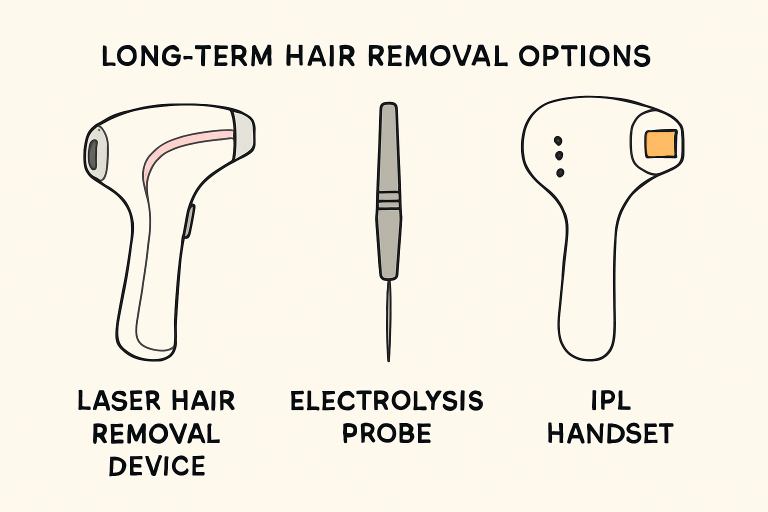Key Takeaways
- Laser hair removal and electrolysis offer proven, long-term reduction and removal of unwanted hair.
- Individual factors—skin tone, hair color, pain tolerance, budget, and available time—influence the optimal method.
- Recent technological innovations make long-term solutions safer and more effective than ever.
Struggling with unwanted hair is a common experience that affects confidence and comfort. While quick fixes like shaving and waxing deliver immediate results, these methods require frequent upkeep and can often lead to irritation and ingrown hairs. Pursuing longer-lasting solutions has driven many to seek professional advice, with a hair assessment Southfield, MI, offering a personalized roadmap based on your skin type, hair texture, and desired results. Personalized assessments are vital in identifying which hair removal method works best for your unique needs and goals. Understanding the spectrum of enduring hair removal options—from modern laser therapies to time-tested electrolysis—empowers you to make well-informed decisions. Each technology has its own strengths and limitations, making professional guidance invaluable as you weigh your options. Consulting with specialists during a hair assessment lets you learn what is possible for your skin and hair type and what to expect regarding permanence, safety, and investment.
Laser Hair Removal: Harnessing Light for Lasting Results
Laser hair removal utilizes focused beams of light that penetrate the skin, targeting the pigment in hair follicles to disable their future growth. This approach works particularly well for people with lighter skin and darker hair, as the dark pigment absorbs the laser energy. The outcome is a significant reduction after several sessions, with many individuals experiencing up to 90% permanent hair reduction in treated areas after a recommended series of treatments. However, those with lighter hair colors or deeper skin tones may see variable results, as the contrast between hair and skin is key to success. Regular touch-up sessions may be needed to maintain results, particularly if hormonal changes stimulate regrowth.
Electrolysis: The FDA-Approved Permanent Solution
Electrolysis is the only hair removal method cleared by the FDA as truly permanent. This technique involves inserting a fine probe into each hair follicle to deliver a small electrical current, destroying the follicle and preventing future growth. Electrolysis is effective for all hair colors and skin types because it does not rely on pigment but instead targets the root structure of the hair. The process can be time-intensive despite its reliability since each follicle is treated individually. It is best suited for smaller areas or those committed to a gradual path to total hair removal. Because of its versatility, electrolysis is often the go-to method for individuals with blonde, gray, or red hair who do not respond to laser treatments.
Intense Pulsed Light (IPL): A Versatile Alternative
Intense Pulsed Light (IPL) resembles laser treatments but uses a broad spectrum of light wavelengths to target hair follicles. IPL is often favored for its versatility and availability—at-home IPL devices bring professional-like treatments into the comfort of your home. However, they generally feature less power than those used in clinics. IPL works best on individuals with light skin and dark hair and often requires more sessions to achieve desired results. Though less precise, its flexibility makes it popular for those seeking gradual hair reduction across larger areas.

Comparing Costs and Long-Term Value
Investing in laser hair removal or electrolysis may seem expensive initially. Still, these professional treatments often offer better value when factoring in the cumulative costs of razors, waxing kits, and regular salon appointments over the years. Beyond financial savings, permanent options dramatically reduce daily or weekly maintenance time, freeing up your routine and providing lasting smoothness.
Considerations for Choosing the Right Method
Several factors influence which long-term hair removal solution is ideal for you:
- Skin and Hair Type: Laser is optimal for high-contrast hair and skin combinations, while electrolysis suits all variants.
- Pain Tolerance: Both methods involve some discomfort—laser typically feels like a mild snap, and electrolysis involves a slight sting as electricity destroys each root.
- Time Commitment: Electrolysis can require numerous treatments over an extended period, depending on the treatment area and hair density, while laser sessions tend to be fewer per area but spaced weeks apart.
- Budget: Assess upfront costs and the combined time and financial expenses of ongoing maintenance versus one-time permanent reduction.
Advancements in Hair Removal Technology
The field is evolving quickly, with newer technologies focused on enhancing comfort and broadening accessibility. Innovative cooling mechanisms, AI-powered devices that calibrate settings automatically for different skin types, and faster, less invasive procedures are redefining patient experiences. As consumer demand rises, expect further innovation and expanded options for safe, effective long-term solutions. For updates on these technological strides, Forbes Health provides proper coverage.
Conclusion
There has never been a better time to explore sustainable solutions for unwanted hair. By leveraging technological advances, consulting experienced professionals for a tailored hair assessment, and evaluating your preferences and needs, you can find a long-term hair removal path that aligns with your lifestyle. The right solution offers not just smooth skin but also peace of mind and freedom from the cycle of temporary fixes.



